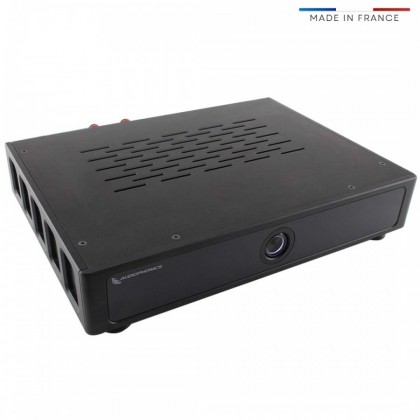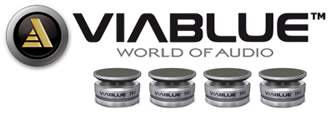bonne fabrication de la part d'Audiophonics pour cet ampli mono à base du module Purifi 1ET6525sa. Le boitier est très joli. Cependant, il y a une chose qui me plait un peu moins et on le ressent à l'écoute, c'est le Désymétriseur. Je pense sincèrement qu'il apporte comme une distorsion ou du bruit. En tout cas l'ampli me semble moins reposant que d'autre ampli Purifi que j'ai eu avant. Ce n'est pas grave en soit, il suffit de brancher une autre prise xlr en direct puisque de toute façon ces ampli purifi sont des amplis symétriques. C'est une bonne initiative de la part d'Audiophonics d'avoir intégré une prise rca mais malheureusement la qualité du signal empathie. Sinon je suis ravi, ce sont de très bons petits blocs mono
Nouveau client ?
Créez votre compteAucun produit
Les prix sont TTC
En achetant ce produit vous obtenez 71 points de fidélité
Accessoires pour ce produit

Audiophonics AP300-M450ET Amplificateur de Puissance Class D Mono PURIFI 1ET6525SA 1x450W 4 Ohm

Nous sommes fiers de vous proposer le Audiophonics AP300-M450ET, un amplificateur de puissance mono classe D basé sur un module Purifi 1ET6525SA. Cette version déjà montée et prête à l'emploi s'adresse aux audiophiles soucieux de s'équiper d'une solution d'amplification à toute épreuve, avec une réserve de puissance considérable ainsi qu'une une linéarité irréprochable. Le module PURIFI 1ET6525SA figure en effet parmi les solutions d'amplification classe D les plus rigoureuses du marché, avec des performances mesurées tout simplement exceptionnelles.
L'ensemble offre une restitution sonore de haut niveau qui conviendra pour accompagner des enceintes exigeantes, pour sonoriser de vastes pièces d'écoute ou pour les applications studio nécessitant un headroom considérable sans faire de compromis sur la précision et la richesse du message audio.
L'ensemble des composants est intégré dans un boîtier en aluminium sobre, robuste, design et compact. Celui-ci dispose d'ouvertures afin de favoriser la dissipation de chaleur. Sa conception lui permet également de limiter l'impact des interférences sur le signal.
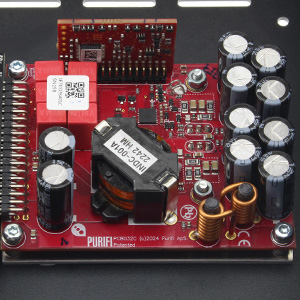
Audiophonics AP300-M450ET : Module PURIFI 1ET6525SA
- Pour son unique canal d'amplification, le AP300-M450ET utilise un module PURIFI 1ET6525SA. Ce circuit amplificateurs classe D haute performance offre une puissance très confortable de 450W sous 4Ω ou 230W sous 8Ω tout en profitant du formidable rendement des amplificateurs classe D.
- Le module 1ET6525SA embarque une boucle de gain élevée supérieure à 85dB sur toute la bande de fréquence, procurant de hautes performances sur l'ensemble du spectre, surpassant n'importe quel amplificateur toutes classes confondues.
- Hyper-performants sur le plan de la distorsion d'intermodulation (IMD), ces modules permettent au AP300-M450ET de proposer une image stéréophonique d'une précision redoutable sur l'ensemble du spectre, pour une clarté redoublée, même durant les œuvres musicales les plus complexes.
- La distorsion harmonique (THD) est maintenue à un niveau extrêmement bas à tous les niveaux de puissance. Cela se traduit par une absence de signature sonore et par une capacité à reproduire tous les types de musiques sans coloration.
- Le bruit de sortie est négligeable, ce qui autorise des silences profonds et favorise l'apparition de détails lors de d'écoutes à faible volume.
- Le circuit profite d'un haut niveau de réjection (PSRR) qui réduit au minimum l'impact de l'alimentation sur les performances audio.
- La réponse en fréquence indépendante de la charge permet de profiter de toutes les qualités de cette technologie d'amplification, y compris avec les enceintes les plus difficiles à driver.
- Faible consommation au repos et rayonnement électromagnétique (EMI). La boucle de gain élevée soulage considérablement la charge de travail des MOSFET et leur permet d'opérer dans des conditions de fonctionnement optimales, réduisant les pertes et les émissions EMI.
- Le AP300-M450ET voit son module d'amplification relié avec une carte d'interface développée spécialement pour une intégration optimale.
Audiophonics AP300-M450ET : Module d'Alimentation HYPEX SMPS600N400
L'alimentation à découpage SMPS600N400 est un modèle à très haut rendement capable de développer une puissance nominale de 600W dans un encombrement extrêmement réduit. Elle a été spécifiquement conçue et développée par HYPEX pour fournir la tension nécessaire au fonctionnement optimal du module amplificateur.
Cette alimentation de qualité à faible bruit, satisfait en tout point les besoins énergétiques du module d'amplification. Par ailleurs, le module d'amplification lui-même possède une excellente capacité à rejeter les bruits d'alimentation. Le AP300-M450ET est ainsi extrêmement peu sensible aux imperfections liées au réseau électrique et aux variations de tension / courant susceptibles de provoquer des bruits parasites.
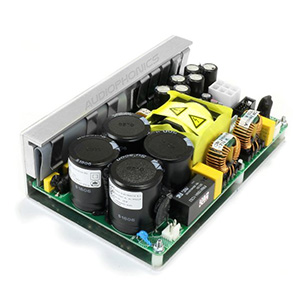
Audiophonics AP300-M450ET : Carte d'interface Audiophonics
Le module d'amplification est piloté par une carte interface de notre conception.
Un AOP Audiophonics OPA1656 est utilisé, cet AOP à très faible distortion offrant la plus grande transparence avec un très faible THD. Il est monté sur socket permettant si besoin leur remplacement.
Pour convenir à toutes les utilisations, nous avons opté pour 4 réglages de gain, sélectionnables par jumper sous l'appareil : 12.5dB, 20dB (default), 25dB and 29dB.
Audiophonics AP300-M450ET : Connectique
Pensé pour une intégration aisée, le AP300-M450ET possède une entrée mono symétrique (XLR) et asymétrique (RCA). Un sélecteur bipolaire permet de changer facilement de source en entrée.
En sortie, des borniers BP-207 isolés Carbone / Or 24k Ø5.5mm assurent une excellente connexion avec les enceinte

Audiophonics AP300-M450ET : Trigger
Le AP300-M450ET possède une entrée trigger 5-12V intégrée dans un circuit basse consommation (5mA). Vos blocs d'amplificateurs pourront ainsi rejoindre aisément vos installations Haute Fidélité avec allumage piloté à distance.
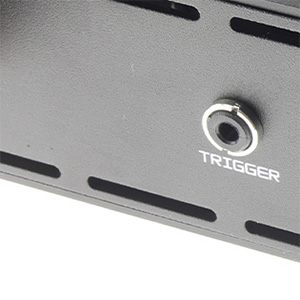
Audiophonics AP300-M450ET : THD vs Freq
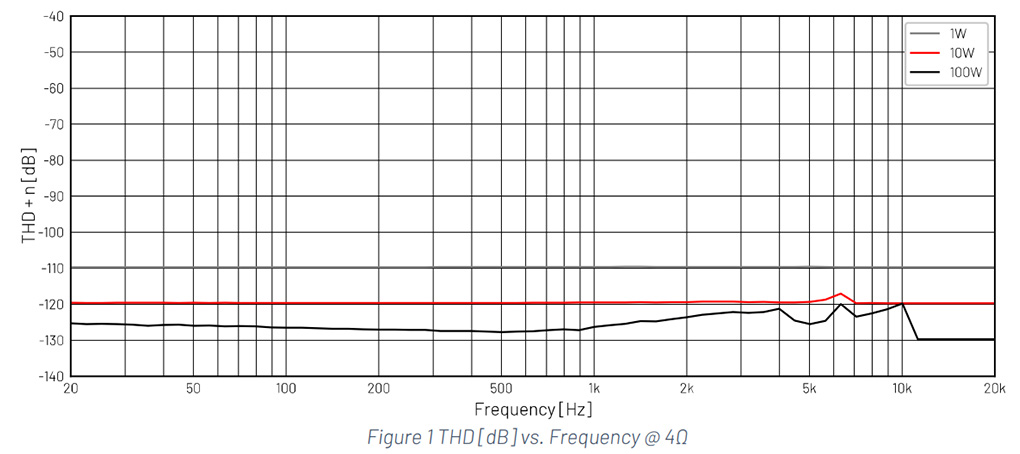
Audiophonics AP300-M450ET : THD+N
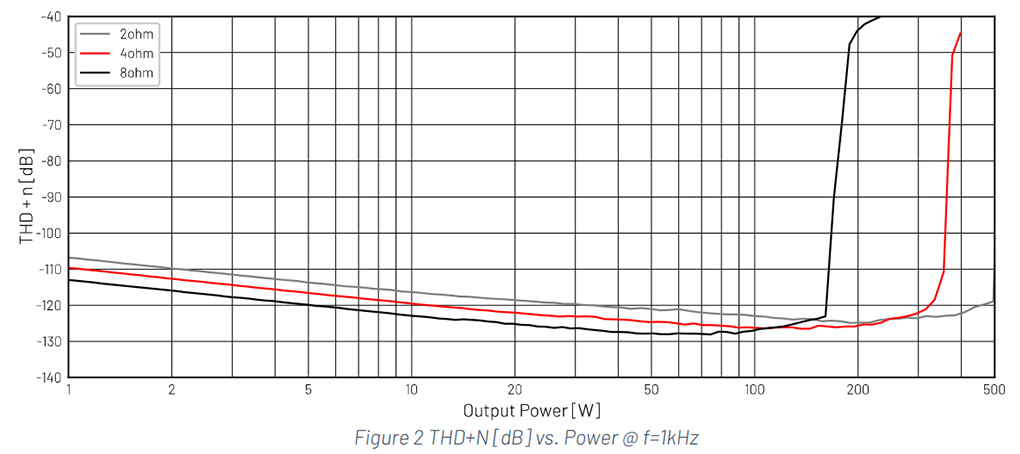
Audiophonics AP300-M450ET : Réponse en fréquence
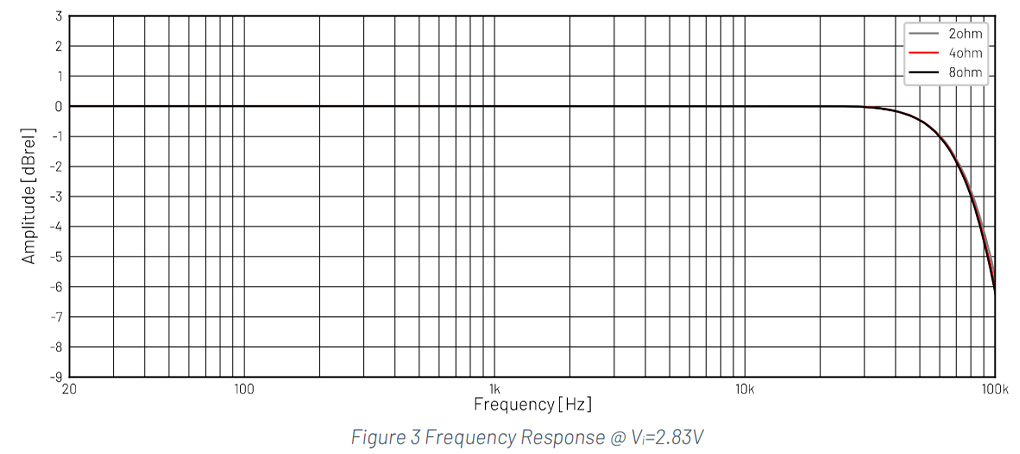
Caractéristiques techniques
| Spécifications | |
|---|---|
| Type de produit | Amplificateur de puissance |
| Entrées | 1x XLR mono symétrique 1x RCA mono asymétrique |
| Sortie | 1x Borniers enceintes |
| Puissance | 1x 230W @ 8Ω, 1%THD 1x 450W @ 4Ω, 1%THD 1x 510W @ 2Ω, 1%THD |
| Taux de distorsion harmonique plus bruit (THD+N) | 0.00035% @ PO=1W, f=1kHz 0.0001% @ PO=10W, f=1kHz 0.00005% @ PO=100W, f=1kHz 0.00035% @ PO=1W, f=20Hz-20kHz 0.00029% @ PO=10W, f=20Hz-20kHz 0.0001% @ PO=100W, f=20Hz-20kHz |
| IMD (CCIF) | 0.0000003% @ PO=1W, f=18.5kHz+19.5kHz 0.0000006% @ PO=10W, f=18.5kHz+19.5kHz 0.0000005 % @ PO=100W, f=18.5kHz+19.5kHz |
| IMD (DIM) | 0.002% @ PO=1W, DIM30 0.002% @ PO=10W, DIM30 0.009% @ PO=100W, DIM30 |
| Bruit au repos | 6.6µV (A-Weighted) |
| Plage dynamique | 137dB @ 4Ω (A-Weighted) |
| SNR | 137dB @ 4Ω (A-Weighted) |
| Réponse en fréquence | 20Hz - 20kHz ±0.01dB @ RL=8Ω 20Hz - 20kHz ±0.01dB @ RL=4Ω 20Hz - 20kHz ±0.01dB @ RL=2Ω |
| Impédance en sortie | Iout = 1A @ 0.03mΩ, 1kHz Iout = 1A @ < 0.35mΩ, 20Hz-20kHz |
| Impédance en entrée | RCA : 10kΩ XLR : 20kΩ |
| Gain / Sensibilité d'entrée XLR pour puissance max à 1% THD | 12.5dB / 10.06Vrms 20dB / 4.24Vrms 25dB / 2.39Vrms 29dB / 1.51Vrms |
| Gain / Sensibilité d'entrée RCA pour puissance max à 1% THD | 12.5dB / 5.03Vrms 20dB / 2.12Vrms 25dB / 1.24Vrms 29dB / 0.75Vrms |
| Général | |
|---|---|
| Alimentation | 100-240V AC |
| Dimensions totales (LxPxH) | 300 x 248 x 62mm |
| Poids | 1.98kg |
| Matériau boîtier | Aluminium |
| Couleur | Noir |
| Conditionnement | 1x Audiophonics AP300-M450ET 1x Câble secteur |
| Entrées | RCA |
| Entrées | XLR |
| Sorties | Borniers enceintes |
| Couleur | Noir |
| Canaux | 1 (Mono) |
| Class | Class D / T |
| Composant amplification | Purifi 1ET6525SA |
| Puissance (W) | 450.0 |
| Télécommande | Non |
Note moyenne 5.0 / 5 7 avis | Pourquoi donner votre avis les produits ? Vous pouvez partager votre expérience tout en informant d'autres clients |
Mathias L.
bonne fabrication de la part d'Audiophonics pour cet ampli mono à base du module Purifi 1ET6525sa. Le boitier est très joli. Cependant, il y a une chose qui me plait un peu moins et on le ressent à l'écoute, c'est le Désymétriseur. Je pense sincèrement qu'il apporte comme une distorsion ou du bruit. En tout cas l'ampli me semble moins reposant que d'autre ampli Purifi que j'ai eu avant. Ce n'est pas grave en soit, il suffit de brancher une autre prise xlr en direct puisque de toute façon ces ampli purifi sont des amplis symétriques. C'est une bonne initiative de la part d'Audiophonics d'avoir intégré une prise rca mais malheureusement la qualité du signal empathie. Sinon je suis ravi, ce sont de très bons petits blocs mono
Tsvetan A.
I have bought the Purifi to use for my Monitor Audio Silver C350 center, which before was powered by the receiver (Marantz SR6015), i wasnt expecting much, but to be honest the difference is big, much clearer voices/effects in movies, and for music... everything is better - voices, highs, even bass is tighter. Now a new problem - the rest of the speakers are lacking, heh. I Recommend it for center speaker with two hands!
Hans B.
It is a real pleasure to deal with audiophonics. Questions are answered immediately. Problems are solved quickly in favor of the customer. Here and there you can find some items a few euros cheaper elsewhere in the net but it is not worth the hassle if something goes wrong.
Now about the amps:
Coming from a UCD400hxr and a purifi ET400 this is my third iteration of a class d amp. It is driven as part of an full range system in a professional environment with dedicated studio acoustics. The mains are cleaned and have private electrical neutral and savety earth lines for the audio gear to bring ground loop noise down.
I always drive class d amps balanced without input buffer using high current preamps that can drive low input impedance gear with ease.
Some comments about the implementation of the modules:
1. When i got the amp I pulled out the opamp and plugged in the dummy opamp hooked it up and let it play while. Coming back i compared it to the ET400 and was surprised that the audiophonics sounded quite veiled in comparison. The quick fix was to pull out the power supply cable going from the input buffer board to the xlr and cinch connector board. Audiophonics decided to make the unbalanced input balanced by using an active circuitry at the xlr and cinch connector board. Obviously the circuitry polluted the signal. Now I got clean sound. (Btw the previous model didn´t use this circuity).
The better fix is to pull out the xlr and cinch board entirely, to buy a xlr connector and solder it directly to the input board using a high quality shielded balanced cable .
2. Opamp implementation: the opamp is introducing more color than I expected. (I compared the op amp level matched in low gain setting to the unbuffered input.) I am convinced that a top notch implementation using a dedicated high end power supply for the opamp would bring down opamp noise down a bit...and price up obviously...As I don´use it I don´t care.
3. To have an opamp socket is nice to have for those customers who like playing around with different thd profiles of different opamps. But with time resistance is building up at the contact points. So plug the opamp in and out from time to time. More important for the same reason: toggle the xlr cinch input switch from time to time (it is not a gas tight relay) and plug in and out the signal cable at the buffer input board. I would like to have these things soldered, including the speaker cables at the buffer board.
4.The power supply is getting quite hot. For better heat dissipation I would prefer that it makes contact with the metal case. The purifi modules itself are running very cool.
5. I can´t comment on the quality of the single ended input in comparison to the balanced one as I have no use for it.
6. I do like the binding posts. They allow for cranking down the calble super tight.
Final words:
The purifi modules are ment to be driven balanced. To provide single ended inputs in my opinion is mainly a marketing decision. Unfortunatly here this decision impacts the purity of the signal when going in balanced.
Fortunately pulling out the power supply cable of the symmetry circuitry is an easy solution as long as you don´t need the single ended input.
In this implementation the modules should be driven without input buffer opamp as they color the sound too much for my taste. You miss out how beautifully clean these modules can sound when the opamp is not installed.
If you like uncolored amps, have an great room with great speakers, great upstream electronics and clean mains power you can enjoy absolutely truth telling amplification for little money. Therefore it is also excellent in revealing minuscule differences when you shoot out upstream gear.
If you are a mixing or mastering engineer these modules tell you everything to make the right decisions, especially in the top end where many amps lack accuracy. If it sounds harsh on these it is harsh and needs to be adressed.
Price of the amps is excellent. It is not worth building one youself. I can whole heartly recommend this purifi build if you go in balanced bypassing the opamp.
Siegfried F.
Geoffroy T.
Bonjour,
Ces amplis de puissance drivent parfaitement mes Revival Audio Atalante 5 dans toutes les situations d'écoute.
J'ai opté pour ces amplis car je peux les cacher dans un meuble.


